Business Intelligence (BI) has never been more important for the health and growth of organizations, which need cutting-edge insights to revolutionize their work. It is a technology-driven process that turns data into actionable insights – vital for building competitive strategies and streamlining business processes. In a lean economy where businesses need the right approach, a robust BI process is a necessity for the data-driven future.
Complementing this is Reverse ETL, a process which offers a new and faster way to use data to drive business value, and makes the insights accessible to multiple teams across a business in an easy-to-digest way. When this is combined with a cross-organisation culture of collaboration, employees will be empowered to make the key choices that help them soar over time. Hand-in-hand, BI and Reverse ETL are important for the future survival of most organizations.
What is reverse ETL?
With the above in mind, what exactly is Reverse ETL? In short, ETL (Extract, Transform, Load) and ELT (Extract, Load, Transform) both transfer data from systems such as business applications into data warehouses. ETL sees data transformed into a usable form before being loaded into a data warehouse. With ELT, the data is loaded into the data warehouse and transformed there; it’s typically faster than ETL.
Reverse ETL turns this on its head. It sees the data warehouse as the source, with a transformation inside the warehouse before data is loaded into third-party applications used across the business, for example CRM (Customer Relationship Management) or ERP (Enterprise Resource Planning) software.
Bypassing the BI bottlenecks
The benefit of Reverse ETL is that it allows businesses to avoid common bottlenecks in the use of data, where data is restricted to one hyper-specialized team within the business. By bypassing traditional BI outputs such as dashboards and reports, data is pushed directly into the hands of line-of-business (LOB) users, who work with CRM and ERP software (for example) regularly. These users can extract maximum value from insights, as they are delivered into the software they work with daily, in a form that’s easy to understand.
Rather than being delivered via specialist data teams, or via management, business insights are served directly to the teams (for example, sales or marketing) who are dealing with customers and driving new business. This can make it far quicker to extract business value from data, and help inform direct actions over time.
For example, Reverse ETL can push customer data into software such as Salesforce, offering salespeople information to enhance the sales process, or combining support, sales and product data in software such as Hubspot to create personalized marketing campaigns. Sales teams can target free trials to users based on their buying history, for example, and marketers can target their campaigns more precisely.
Moving to a ‘self-service’ data model
Further, Reverse ETL also helps businesses to avoid the congestion that is common with normal BI processes. Dashboards, reports and visualizations help organizations to drive initiatives and make decisions – but the process can be upset by slow roll-outs or BI reports, which are ignored by teams. In too many companies, data warehouses have almost become a silo in themselves, with a barrier between the data and the data consumers within a business, and data teams too overworked to deal with every problem.
This can be addressed via Reverse ETL, as data warehouses can operationalize data by pushing it out to stakeholders throughout the organization. Reverse ETL can also help with conventional BI processes, moving data from a data warehouse directly into BI platforms. Teams can make use of data instantly, and act on it in real-time via change data capture.
BI dashboards and reports are, of course, still useful. But in future, they will work alongside Reverse ETL-enabled use of data within third-party applications. This is part of a broader move to ensure business users have easy access to data, helping to unleash its transformational potential.
Freeing your data to do its work
Altogether, the potential for businesses is seismic in scope. Reverse ETL is set to be a key component of the modern data stack for many organizations, meaning that the potential of data is no longer controlled by specialists or hoarded by management. It’s part of a more general shift towards a ‘self-serve’ model for data, where business users are empowered (and educated) to source and use the data they need themselves.
Going forward, data teams will increasingly have a facilitating role, building a self-service data architecture which will help to drive business value (alongside traditional BI tools). For every business, the volume of data is increasing, and for busy data teams, it’s important to be able to allow business users to operate autonomously: the power of Reverse ETL in operationalizing business data will be central to this.
Complete user autonomy is still some way off for most companies, with many data consumers still resolving issues through IT. But with the volume of data increasing for every business, Reverse ETL will be crucial in ironing out these lengthy, manual interventions and creating a ‘horizontal’ data culture, rather than a top-down one, empowering business users with the data they need to make the right decisions, when they need it.
Ready to see how Rivery can turn your warehouse data into action-ready data? Try Rivery’s Reverse ETL for free
Can't miss insights
Minimize the firefighting. Maximize ROI on pipelines.





